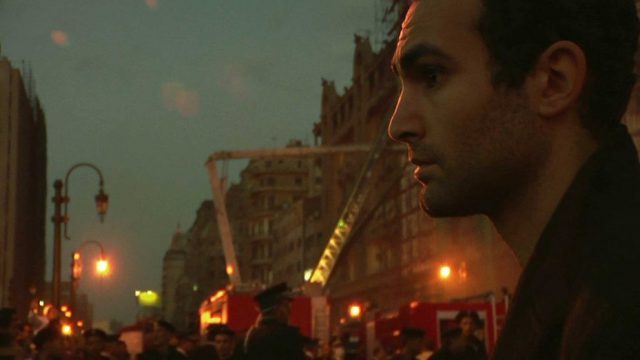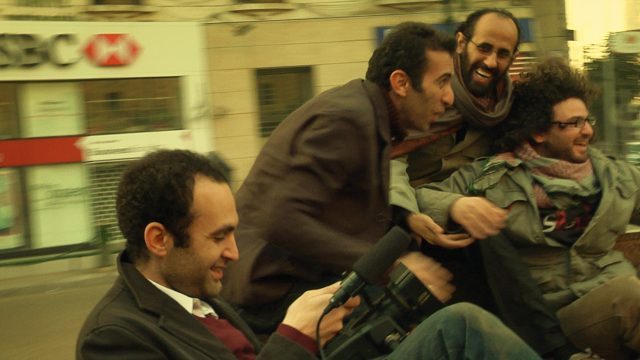
Khalid (Khalid Abdalla) experiences loss of many kinds in Cairo in Tamer El Said’s In the Last Days of the City
IN THE LAST DAYS OF THE CITY (Tamer El Said, 2016)
Museum of Modern Art, MoMA Film
11 West 53rd St. between Fifth & Sixth Aves.
April 27 – May 3
212-708-9400
www.moma.org
bigworldpictures.org
 Tamer El Said’s extraordinary debut feature, In the Last Days of the City, is an elegiac love letter to his deeply troubled hometown, Cairo, as well as a treatise on the responsibilities filmmakers have to their art and to society as a whole. Almost ten years in the making, the film was shot between 2008 and 2010, finishing shortly before the Arab Spring uprising in January 2011 in Tahrir Square, and was not completed and screened until 2016, when it started winning prizes at festivals around the world. It finally receives its New York theatrical release at the Museum of the Modern Art, running April 27 through May 3, where El Said will take part in a postscreening conversation on opening night at 7:00; in addition, on April 30 at 7:00, MoMA’s “Modern Mondays” series will present “An Evening with Tamer El Said,” in which the director will discuss Cairo’s Cimatheque — Alternative Film Centre, which he and actor and activist Khalid Abdalla cofounded in 2012 to help grow independent cinema in Egypt. In the Last Days of the City is about loss of all kinds; Abdalla (The Kite Runner, United 93) stars as Khalid, a thirtysomething filmmaker living in Cairo whose life is unraveling: His girlfriend, Laila (Laila Samy), has left him, he needs to find a new apartment, his hospitalized mother (Zeinab Mostafa) is very sick, and his city is crumbling right before his eyes. He meets with three friends and fellow filmmakers, Hassan (Hayder Helo), from Baghdad, Tarek (Basim Hajar), an Iraqi living in Berlin, and Bassem (cinematographer Bassem Fayad), from Beirut. They decide that each of them is going to film their cities and send the footage to Khalid, who will incorporate it into the work he is already making but has reached a block. Throughout, radios and televisions report state news about Hosni Mubarak, the Egyptian football team, and the Muslim Brotherhood, revealing Egypt to be a country on the brink of something big, but neither the characters nor the filmmaker expected what actually occurred.
Tamer El Said’s extraordinary debut feature, In the Last Days of the City, is an elegiac love letter to his deeply troubled hometown, Cairo, as well as a treatise on the responsibilities filmmakers have to their art and to society as a whole. Almost ten years in the making, the film was shot between 2008 and 2010, finishing shortly before the Arab Spring uprising in January 2011 in Tahrir Square, and was not completed and screened until 2016, when it started winning prizes at festivals around the world. It finally receives its New York theatrical release at the Museum of the Modern Art, running April 27 through May 3, where El Said will take part in a postscreening conversation on opening night at 7:00; in addition, on April 30 at 7:00, MoMA’s “Modern Mondays” series will present “An Evening with Tamer El Said,” in which the director will discuss Cairo’s Cimatheque — Alternative Film Centre, which he and actor and activist Khalid Abdalla cofounded in 2012 to help grow independent cinema in Egypt. In the Last Days of the City is about loss of all kinds; Abdalla (The Kite Runner, United 93) stars as Khalid, a thirtysomething filmmaker living in Cairo whose life is unraveling: His girlfriend, Laila (Laila Samy), has left him, he needs to find a new apartment, his hospitalized mother (Zeinab Mostafa) is very sick, and his city is crumbling right before his eyes. He meets with three friends and fellow filmmakers, Hassan (Hayder Helo), from Baghdad, Tarek (Basim Hajar), an Iraqi living in Berlin, and Bassem (cinematographer Bassem Fayad), from Beirut. They decide that each of them is going to film their cities and send the footage to Khalid, who will incorporate it into the work he is already making but has reached a block. Throughout, radios and televisions report state news about Hosni Mubarak, the Egyptian football team, and the Muslim Brotherhood, revealing Egypt to be a country on the brink of something big, but neither the characters nor the filmmaker expected what actually occurred.

Four friends meet in Cairo and decide to collaborate on a film in Tamer El Said’s In the Last Days of the City
Fayad captures a city bathed in a golden glow and facing an ominous future. Historic locations are surrounded by buildings turned into rubble. El Said and editors Mohamed Abdel Gawad, Vartan Avakian, and Barbara Bossuet cut between the film and the film-within-the-film, as Khalid interviews Maryam (Maryam Saleh), Hanan (Hanan Youssef), Laila, and others, trying to find out more about himself and his past as well as the Cairo he loves and fears. In a nod to the French New Wave, the camera occasionally continues on a subject with the dialogue not synced — for example, they look out contemplatively, their mouth not moving, their words heard in voice-over. The camera often loses focus, blurring the character as Khalid wrestles with various aspects of his life and career. Most of the film is improvised — El Said initially wrote a fake script in order to get permits, then went through numerous rehearsals before starting shooting. Although there are autobiographical elements, including Khalid living in El Said’s own apartment, the director considers it more of a personal venture and not about himself, a melding of fiction and reality. The film moves with the pace and rhythm of the city as a cloud hangs over it; while it was clear that something was going to happen, El Said did not anticipate the revolution that took place, centered in Tahrir Square. He also chose not to film any of the actual riots and protests and instead decided to participate and join the fight. It’s an option that Khalid does not take in the film; there are several scenes in which he sees violence but decides to either walk away or photograph it without trying to stop it or report it.
In the Last Days of the City is very different from the 2011 documentary Tahrir, in which Italian director Stefano Savona immediately went to Cairo upon hearing about the rebellion, got right in the middle of the action, and released the film shortly after the events. In the Last Days of the City is very much about the filmmaker’s role in the social contract. One of the reasons it took so long for El Said to complete the film was because he and Khalid, who was a major figure in Jehane Noujaim’s 2013 documentary, The Square, also about the Arab Spring, spent several years constructing and establishing Cimatheque, an arts institution where independent filmmakers can flourish in a country without any kind of cinematic infrastructure. Of course, there were budgetary issues as well. In the end, even though In the Last Days of the City very specifically searches for the soul of Cairo, it could really be about any person trying to find his or her place in their hometown, as change — personal, political, societal — looms on the horizon.